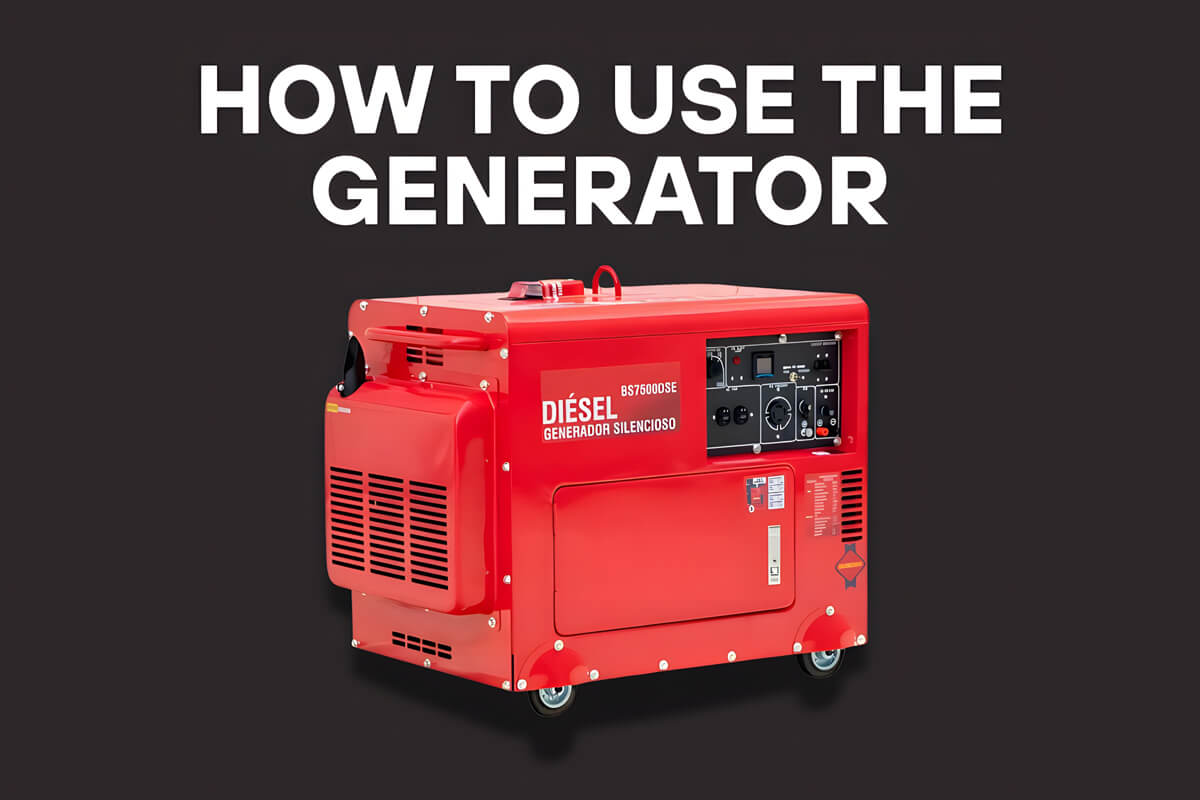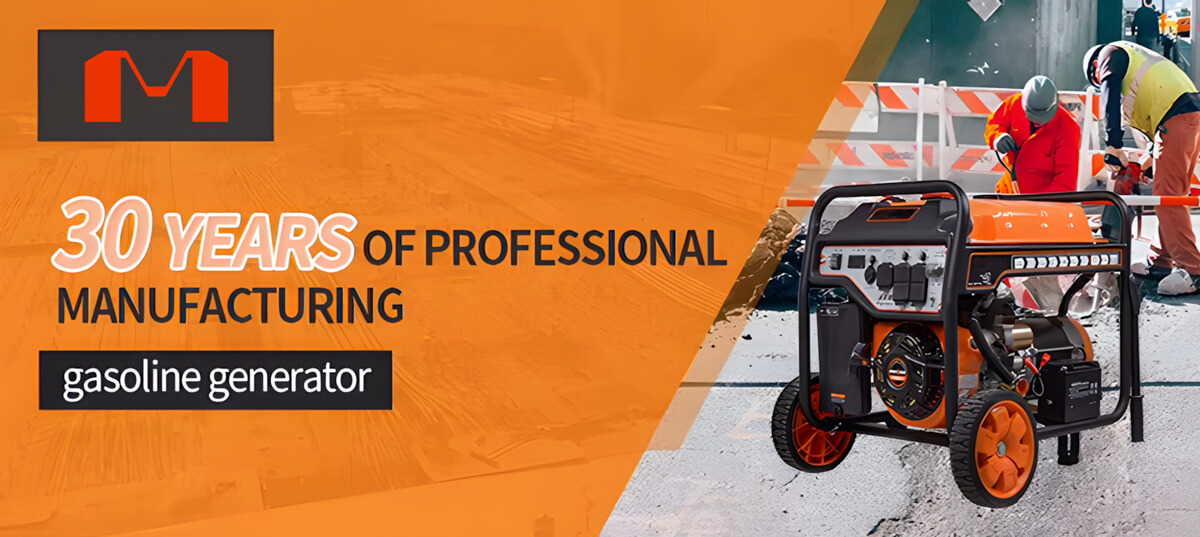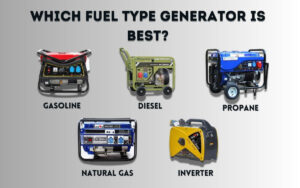How to use the generator
A generator is an easy way to generate power when the grid goes down due to natural or artificial causes. Whether you’re new to using a generator or well-seasoned, there are a few things you need to know to operate it safely. They are commonly used for backup power during outages, on construction sites, or for outdoor events.
Learning how to properly use a generator is essential for both safety and efficiency. The best way to keep your generator running safely is to familiarize yourself with it before you need it. Plan what you want to power and how to use the generator to supply those loads.
Want to know how to use the generator? This step-by-step guide will provide everything you need to know to operate your generator effectively.

Safety precautions
Portable or standby generators can be useful during long-term power outages, but they can be dangerous if not used properly. Contact an electrician to help determine the best generator for your needs. Always read and follow the manufacturer’s instructions before use.
Safe distance for a generator
Place the generator at least 20 feet away from the house, with the engine vent facing away from windows and doors. The total length from the generator to the appliance should not exceed 100 feet to prevent voltage drop, which can cause the appliance’s motor and compressor to burn out prematurely.
Run it on a level surface
Many generators have splash lubrication systems that spray oil onto moving parts. If the generator is on a slope, the dippers can’t properly lubricate the engine, which may cause damage. Keep your generator on a level surface, even if you have a pressurized lubrication system.
Carbon monoxide safety
Generators produce carbon monoxide (CO), which is deadly. Never place a generator in a utility building, garage, basement, or any enclosed space. Always run it outdoors in a well-ventilated area, away from doors, windows, or vents. Some modern generators come with CO detectors that shut down the machine if CO levels become dangerous.
Fuel safety
Always use the correct fuel for your generator. Never refuel while the generator is running or hot. Make sure it is turned off and cooled down before refueling. Store fuel in approved containers and keep it away from hot objects like heaters or grills. Be mindful that the muffler can get hot enough to melt plastic, so keep fuel containers at a safe distance.
Electrical safety
Generators pose electrical hazards, mainly when operated in wet conditions. Use the generator only when necessary in damp conditions; protect it by running it on a dry surface under an open, canopy-like structure where water cannot form puddles or drains under it. Always make sure your hands are dry before touching the generator.
Using a GFCI transfer switch
The National Electrical Code (NEC) recommends GFCI (ground fault circuit interrupter) outlets on dual-voltage generators (120V and 240V). Generators equipped with GFCI outlet receptacles need a transfer switch designed specifically for them. This switch may be called a three-pole or a GFCI-compatible switch and is also required by the NEC. When you throw this switch, you disconnect the generator-supplied circuits from the two 120-volt utility-supplied circuits and disconnect the third leg of the utility-supplied circuit.
If you use a typical 2-pole transfer switch (one that does not disconnect the neutral) on a GFCI-equipped generator, the GFCI outlets will close. Using this switch is a code violation, and by defeating the GFCI receptacles, you’d limit the generator’s capacity. You can use a 3-pole or 2-pole transfer switch on all other types of (non-GFCI) generator types.
Using a transfer switch
The easiest way to use a portable generator for home power backup is with a manual transfer switch. The generator gets connected to the transfer switch with a heavy-duty cable, which plugs into an outlet receptacle installed outside the house (this receptacle is officially called a “power inlet box”). A cable runs from the outlet to the transfer switch inside the house. Power from the generator travels through the genset cord, receptacle, internal cable, transfer switch, and circuit breakers to the various circuits you need to power safely.
A transfer switch has three purposes:
Isolate the home circuits you want to power, leaving all other circuits without access to power to prevent overloading.
Electrically separates the generator and the home from the grid, preventing the generated power from feeding back onto the grid and injuring utility personnel.
Prevents utility-supplied electricity from powering the home while the generator runs, which could cause an electrical fire and burn the generator.
Use heavy-duty cords
Assuming you don’t have the money to install a transfer switch yet, you can safely run appliances directly connected to the generator. You can power your power tools, refrigerator, and computers by running a long extension cord to the generator. These cords should be heavy-duty and of a wire gauge thick enough to handle the current flowing through them. The cable’s packaging will tell you what electrical load it is rated to supply. Next, the cables must be rated for outdoor use. Finally, route the cords carefully to avoid fraying, kinking, or twisting—especially when powering high-wattage appliances like a heater. Coiled extension cords can get hot and may melt. Avoid using indoor normal extension cords, as they aren’t designed for high-power loads and outdoor conditions.
Understand when and how to use the ground rod
If you plug a heavy-duty extension cord into a generator and connect it to an appliance, power tool, or device, leave out the ground rod. Otherwise, use a ground rod when powering circuits through a transfer switch. Connect a piece of copper wire of the same gauge as the heaviest cable in the circuit you are powering from the ground lug on the generator to the ground rod. For example, if you’re using the generator to power a large item like a 240-volt air conditioner, you may need a 6- or 8-gauge ground wire.
Basic operating steps
Checking fuel and oil
Make sure the generator is well fueled and at the correct level. Before starting, fill the fuel and oil to the recommended levels.
Understanding power requirements
Power Types: Starting power refers to the peak power required to start an appliance, especially a motor like a refrigerator or air conditioner. This is usually higher than running power. Running power is the continuous power required to keep the appliance running after it is started.
- Calculating load: Add the running power of all appliances you plan to connect. For appliances that require high peak power, make sure your generator can handle both starting power and running power. Check the power label or owner’s manual for each appliance to confirm.
- Power capacity considerations: Never exceed the rated power of your generator. It’s best to leave a safety margin to avoid overloading. Generators are designed for temporary use, so prioritize essential appliances. A 5,000- to 8,000-watt generator can usually handle basic household needs like air conditioners, refrigerators, TVs, and lighting.
Connecting appliances
- Direct connection: For small appliances or tools, use an extension cord or power strip that matches the output power of the generator. Make sure they are well grounded and intact. Follow the correct sequence—start the generator, plug the extension cord into the generator, and then connect appliances. When disconnecting, do it in reverse order—unplug appliances first, then the extension cord, and finally turn off the generator.
- Transfer switch: For large installations or permanent installations, use a transfer switch. It isolates the home circuit from the grid, ensuring that important appliances can be safely run directly from the generator.
Starting procedure
- Shut down appliances: Make sure all connected appliances are turned off.
- Fuel valve: Set the generator’s fuel valve to “On.”
- Choke lever: Set the choke lever (if available) to the “Off” position.
- Start the generator: Pull the starter rope or turn the key (depending on your model). After starting, gradually adjust the choke to the “On” position.
Run the generator
After the generator starts, connect appliances one by one to prevent overloading. Make sure you do not exceed the rated power of the generator. While the generator is running, check for unusual noises, smoke, or vibrations. Check the fuel and oil levels regularly. If necessary, disconnect electrical appliances to reduce the load.
Shutting down the generator
Properly shutting down your generator ensures safety and prevents damage to both the generator and connected devices.
- Disconnect appliances: Always unplug all appliances and devices before turning off the generator to avoid electrical surges when it shuts down.
- Turn off the generator: Once all appliances are disconnected, switch off the generator using the designated power control. Typically, this involves flipping the main power switch to the “off” position.
- Allow cooling: Let the generator run without a load for a few minutes to cool down, preventing overheating and ensuring proper shutdown. Wait for the generator to cool before refueling to avoid potential hazards.
- Turn off fuel supply (optional): If applicable, switch off the fuel valve to prevent fuel buildup in the system, which can cause blockages or starting issues later.
- Post-operation checks: After shutting down, inspect the generator for any signs of issues like leaks. Regular maintenance helps ensure long-term reliability.
Conclusion
Using a generator provides essential peace of mind and convenience during power outages. By following the guidelines in this post, you can ensure the safe and efficient operation of your generator, keeping essential appliances running smoothly.
Remember, safety is paramount—always set up your generator in a safe, well-ventilated location, connect appliances correctly, and monitor load to avoid overloading. Regular maintenance and adherence to the manufacturer’s guidelines will ensure the long-term performance and reliability of your generator.
For any questions or expert advice, feel free to reach out. We’re here to help!


May Ge
Outdoor Machinery Export Manager 6-Yr Exp 🌍 ∣ BSCI, EPA, EURO V, CE ∣ Generator, High-pressure Washer, Water Pump, Engine, Floor Scrubber ∣ 🚀 24/7 Second Reply
TAIZHOU BISON MACHINERY CO.,LTD | Ningbo University of Technology
Our related blog

Can you use a regular generator for welding?
MATCHUP will explore the technical requirements of a welding power source, what regular generators can actually handle, and help you understand the difference between them.

Which fuel type is best for generators?
This article is designed to guide you in choosing the right generator fuel type for your specific needs. By exploring the pros and cons of each fuel, we’ll help you make the best decision.

What are the main components of a generator?
MATCHUP will introduce the main components of a generator, how they work together, and their role in efficient power generation.

winterizing your portable generator
Below is a complete guide to winterizing your portable generator. It contains all the tips and tricks you need to know. Keep reading to learn more.





